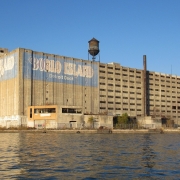North Carolina, In Early Stages of Financial Review, Sees Potentially Large Number of Distressed Water Systems
State officials are developing criteria to identify public water systems at risk of financial failure.

The sewer system in Fair Bluff, a town in eastern North Carolina, has been plagued by financial problems that stem from a loss of population and high infiltration of groundwater that caused treatment bills to spike. The town, which was flooded by hurricanes twice in three years, relied on state and federal grants for repairs. Photo © Brett Walton/Circle of Blue
By Brett Walton, Circle of Blue
North Carolina officials are working to develop a rating system that would identify public water and sewer providers at risk of financial failure. The ratings would allow state funding and technical assistance to target the most distressed communities.
At a June 25 committee meeting of the North Carolina Water Infrastructure Authority, staff from the Department of Environmental Quality outlined draft criteria that will form the backbone of the rating system.
Kim Colson, the director of the water infrastructure division, said that 183 water and sewer systems out of 499 that were analyzed in the draft review could be considered distressed.
“It is a large number,” Colson said.
That number, however, will change as more data comes in and the threshold for defining distress is refined, he said.
Colson hopes that state intervention — in the form of grants, coaching, and assessment tools — can give small systems “the firm foundation that water infrastructure provides, to sustain themselves and redevelop and start growing.”
The coronavirus pandemic has sent financial shock waves through many water utilities as businesses closed and manufacturers shut down. Nationally rural water systems expect to lose about $1 billion in revenue from declining water sales, according to an industry survey.
Even before the pandemic, small water systems were struggling. North Carolina took the historic step last summer of revoking the charter of Eureka, a tiny community whose chronically indebted sewer system had bankrupted the town.
Avoiding more scenarios like Eureka is the goal of Colson and his colleagues. Focusing on the financial and managerial shortcomings of small water systems is a pillar of the state’s water infrastructure master plan, which was published in 2017.
The rating system for identifying water and sewer providers that are on the cusp of failure is the next step in the process.
At the meeting, Colson presented 18 criteria that factor into the ratings. These include financial metrics like debt ratios, operating budgets, revenues, and rates, as well as demographic elements such as population trends. Each of the criteria is worth various points, depending on its importance. The draft proposal considers systems with six or more points to be distressed.
The most important factor in the draft version is a community’s revenue outlook, worth up to six points on its own. This measurement combines population trends and water rates, and indicates the ability to raise revenue in the future to sustain operations.
Communities with declining populations and high water rates are in the deepest trouble, Colson said. Even doubling their rates, in many cases, would not offset extensive repair needs and operational costs, he said. The trend is most apparent for the smallest communities, those with fewer than 1,000 people.
Exceeding the distressed threshold will not trigger any mandatory actions, though it will heighten awareness within state departments.
Many of these distressed systems have the potential to be viable, Colson said. But that requires “resetting the utility.” That could mean an assessment of assets and finances, making improvements in managerial practices, or patching leaky pipes. It could also result in partnership with larger neighbors or regional mergers. For utilities, there are advantages to size: shared billing systems and pooled contracts reduce operating budgets, while having more customers can spread the fixed infrastructure costs across more people. But connecting one system to another often requires several million dollars, which is a significant hurdle for a community already in need.
State assistance for these sorts of ideas might be coming. The North Carolina Legislature is considering a new grant fund for distressed water systems. That bill, which includes provisions to facilitate utility partnerships, is now in negotiation between the House and Senate.
Colson said that there is still “a ways to go” before the ratings are finalized. There is missing data to fill in, and the ratings criteria need to be reviewed by stakeholders outside of the committee.
Nonetheless, committee members seemed pleased with the early stages of the review.
“I think this is going to make a huge difference in our communities,” said committee member Charles Vines, who is also the mayor of Bakersville, a town of about 450 people.
Brett writes about agriculture, energy, infrastructure, and the politics and economics of water in the United States. He also writes the Federal Water Tap, Circle of Blue’s weekly digest of U.S. government water news. He is the winner of two Society of Environmental Journalists reporting awards, one of the top honors in American environmental journalism: first place for explanatory reporting for a series on septic system pollution in the United States(2016) and third place for beat reporting in a small market (2014). He received the Sierra Club’s Distinguished Service Award in 2018. Brett lives in Seattle, where he hikes the mountains and bakes pies. Contact Brett Walton











Leave a Reply
Want to join the discussion?Feel free to contribute!